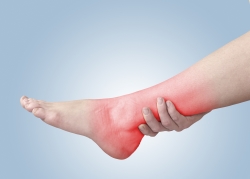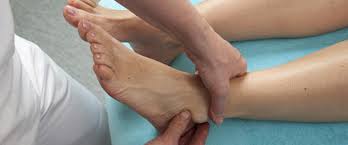There is little doubt about the fun, excitement, and thrill of skateboarding.
Whether you are competing at a high-level event or rolling down the sidewalk on the way to the store, skateboarding is a phenomenon that still has a stronghold on the young and the young at heart.
To perfect the art of skateboarding requires skills, athletic ability, and dedication.
However, skateboarding can also be dangerous. While serious injuries are relatively few and far between, minor injuries ranging from bruises to dislocations are quite common.

Is Skateboarding Bad for Your Ankles?
Skateboarding can be hard on your ankles.
And if you are performing tricks rather than casual skating, it can be very hard.
The damage (such as sprains or even fractures) made to your ankles and feet is majorly due to the repetitive stress that is developed when you jump or perform the tricks.
A few other most common skateboarding injuries may also include:
- Tendonitis
- Plantar fasciitis
- Foot, ankle, or lower leg fractures
- Neuroma or a pinched nerve in the foot
4 Ways to Prevent Skateboarding Ankle Injuries
The ankles are most vulnerable because they have to bear so much of the weight in terms of balancing and propelling the skateboard.
One slip, one false step, and you may find yourself with a sprained ankle.
Plus, once you sprain your ankle, especially a high ankle sprain, the more vulnerable you are to ankle sprains in the future.
This is why you should consider wearing the proper protection, which begins with socks, for those who frequently ride a skateboard.
1- Skateboarding Socks

It may seem like the socks are not that relevant at first, but there are good reasons to wear the proper type of skateboarding socks.
Ideally, you need socks that are comfortable, durable, and provide the right type of protection to the feet without limiting your performance on the skateboard.
This generally means wearing cotton socks that breathe and hug the feet to protect against blisters and the buildup of callouses.
Skateboarding socks are socks designed specifically for the rigors of skateboarding. They are fashioned from tough, durable material and have reinforcements on the areas of the feet that get the most stress.
For those who do not want to wear specialized socks, you can use an old technique of wearing a thin pair of socks and putting a thicker pair of socks over them.
This provides excellent protection from blisters as the two layers keep the pressure points at a minimum on the feet.
2- Skateboarding Shoes

This is where most skateboarding experts and enthusiasts will focus their attention when it comes to protecting their ankles.
The right shoes make all the difference when controlling the skateboard. This means providing enough contact with the board to exercise full control.
And yet having enough given so that the ankles are not bent too far when maneuvering the skateboard.
This means that the soles of the shoes cannot be so sticky that they force the ankle to sprain or even dislocation when executing maneuvers on the skateboard.
There are companies that make specialized shoes for skateboarding.
These shoes tend to be lightweight, crafted from durable materials, and have rubber or synthetic soles that are sticky enough to maintain contact but provide enough give to protect the ankle.
One variation is the old high-top sneakers that were commonplace a half-century ago but are less popular today.
Their lack of popularity may be due to their appearance, but they provide extra protection for the ankles as they take some of the pressure off the twists and turns that skateboarders experience when maneuvering their skateboards.
High-top sneakers are a common sight at skateboard parks, so if you have weak ankles or simply want more protection, they may be the perfect choice for you.
3- Skateboarding Insoles

Another item that has proven to be quite useful for skateboarders looking to protect their ankles is wearing the right insoles.
Over the past couple of decades, a lot of research has been performed to evaluate the stresses put on the ankle that skateboarding causes.
One of the more interesting finds is that the type of arch support the feet get plays a strong role in support of their ankles.
This is why more companies are producing insoles specifically designed for skateboarders.
One of the most popular brands is Remind insoles which many of the top competitive skateboarders use when competing in high-level events.
There are three different types of Remind insoles that are used frequently both by competitors and by those who simply want more ankle protection.
- Cush: Self-molding insole using advanced technology for customized support
- Destin: Designed to handle impacts that occur when skateboarding
- Medic: More protection for the toes and heel, which undergo impacts
Another popular brand is Etcetera insoles which help protect the bottom of the feet while providing more support for the ankle.
Different types under the Etcetera brand emphasize different areas of the feet to support.
However, the overall effect is to help keep the feet in the ready position and not cause too much pressure to be placed on the ankle.
4- Skateboarding Ankle Brace

Ankle braces are becoming more popular for those who have previously suffered ankle sprains.
For those with weak ankles, the braces provide a level of support that helps prevent future injuries.
Some of the best ankle support for skateboarding that is available to buy include:
- SB SOX Compression Foot Sleeves
- BLITZU Foot Care Compression Sleeve
- Ankle Support Brace by Pure Compressions
However, they do not seem to provide any additional protection for those who have yet to sprain their ankles.
In fact, wearing braces on healthy ankles may be counterproductive as it weakens the muscles that surround the joints.
Foot experts suggest that you should, therefore, avoid wearing the ankle braces for long.
These heavy-duty gears are essential if you are more into performing tricks.
In addition, you should always ride safely and avoid riding in heavy traffic areas or at locations that have more number of pedestrians.
Why Does My Ankle Hurt After Skateboarding?
Skateboarding can be hard on your feet and ankles due to the intensity of impact caused when you are performing various kinds of jumps and tricks.
Your ankle or feet may also feel hurt after you have done skateboarding if you are new to skating.
This is because your feet are yet not used to the movements like twisting or rolling of your ankles which is common during skateboarding.
You should get an instructor to learn proper skateboarding techniques when you are new.
Always start by practicing the basic skills, and then after a few sessions, you can move to more advanced stages.
Many times ankle also hurts a lot after the sport if you do not skate regularly or every day.
One of my friends who used to skate almost every day took a gap of about 5 days.
And after 5 days, when he was done with his skateboarding, his ankles, feet, and knees were like killing.
The quality of the surface on which you skate also plays an important role.
To avoid any hurting, you should make sure that you skate on surfaces that are free from rocks, cracks, debris, or any other form of irregularities.
You should completely avoid skating on wet surfaces like on rainy days.
If possible, also avoid those homemade ramps and always insist on ice skating at professionally designed skate parks that are completely safe for you.
Should You Ever Skate After Your Broken Ankle?
I know dealing with a broken ankle or leg is weird, particularly for skateboarders.
But if you happen to get into such a situation during skateboarding your podiatrist is the right person to answer this question.
Based on the severity of your fracture or broken foot, you may or may not be allowed to skate again.
Based on my personal experiences (with my same friend who broke his ankle in 2 places), all I can say is that you should completely avoid sporting when your ankle is healing.
Do not try to ignore the pain or rely on pain killers for skating again.
Believe me; if the fracture is minor, you can still skate after a few weeks. And there is no harm in it as long as your broken ankle has healed up.
A few things you should keep in mind are:
- Never ever hold any moving vehicle while you are on a skateboard
- Crouch down slowly for better control, if you find that you are losing your balance
- Inspect your skateboard regularly. If you find any cracks, loose wheels, or any other flaws, get them repaired or purchase a new skateboard.
These will ensure that you perform the skating in a safe manner.
Summing Up
Whether you have healthy ankles or not, there are simple exercises that help build up the muscles around the joints.
This means that only those with weakened ankles and who perform the exercises should wear ankle braces or ankle guards for skateboarding.
Another important factor in the health and support of ankles is taking the proper precautions when a sprain occurs.
It is important to keep the weight off the ankle, elevate it when possible to reduce the swelling, and keep away from skateboarding until the pain and swelling have fully subsided.
This means that at some point, you will be able to walk normally before you can skateboard, so be careful in this regard.
For those who want to protect their ankles while skateboarding, wearing the proper shoes, socks, and insoles can have a big impact.
They provide the support needed to help you execute maneuvers on the skateboard while minimizing the risk of injury.
Remember that strengthening exercises help a lot and only wear an ankle brace if you are susceptible to ankle sprains.




